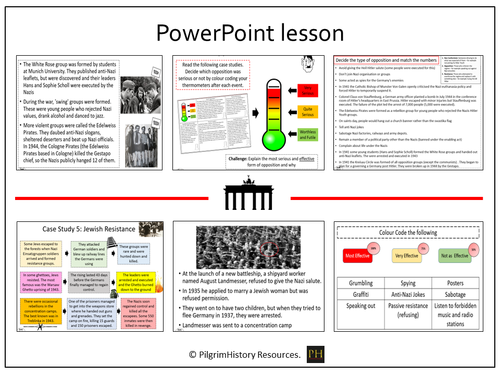


Germany 1890-1945: Democracy and Dictatorship
The aim of this lesson is to assess how effective the different types of opposition were towards the Nazis in Germany.
This lesson is split into three main areas of opposition to the Nazi regime: resistance, non-conformism and open criticism.
The lesson also looks in depth at Church opposition, youth opposition, passive resistance, Jewish resistance and the Stauffenberg Bomb Plot.
Students are given a list of ways of opposing the Nazis which they have to categorise and through some independent research decide the best and most effective forms of opposition.
Moreover by the end of the lesson students will be able to assess and judge why opposition was ineffective against the Nazi state.
The lesson is enquiry based with a key question using a lightbulb posed at the start of the lesson and revisited to show the progress of learning.
The resource includes suggested teaching strategies, retrieval practice, differentiated materials and comes in PowerPoint format if there is a wish to adapt and change.
Get this resource as part of a bundle and save up to 31%
A bundle is a package of resources grouped together to teach a particular topic, or a series of lessons, in one place.
Germany Democracy and Dictatorship Complete Bundle
This bundle is the complete series of lessons I have created for AQA GCSE 9-1 Germany 1890-1945: Democracy and Dictatorship. As well as focusing on GCSE exam practice questions, the lessons apply the skills necessary to enable the students to achieve the highest grades. The lessons will allow students to demonstrate (AO1) knowledge and understanding of the key features and characteristics of the period studied from the Wall Street Crash and the transformation by Hitler of the Nazis into an electable force. They will study (AO2) second-order concepts such as change and continuity in the economic problems facing Germany and the causes and consequences of Hitler becoming Chancellor. The analysis and evaluation of sources (AO3) are used in for example The Night of the Long Knives lessons whilst substantiated judgements are made (AO4) on the limited opposition in Nazi Germany and the conversion into a totalitarian state. The lessons are as follows: L1: Kaiser Wilhelm II (free resource) L2 The Kaiser’s Government and Weltpolitik L3 The impact of World War 1 on Germany (free resource) L4 The Weimar Constitution and Political Parties L5 The Treaty of Versailles L6 Political Uprisings – the Spartacists and the Kapp Putsch (free resource) L7 The Ruhr Crisis and Hyperinflation L8 The Munich Beer Hall Putsch L9 Super Stresemann L10 The Golden Age of Stresemann L11 The Wall Street Crash L12 The rise of the Nazis and the transformation of the Nazi Party L13 How did Hitler become Chancellor? (free resource) L14 How did Hitler consolidate his power? L15 The Night of the Long Knives L16 The Nazi Police State L17 The Nazis and the economy L18The Hitler Youth L19 The role of women in Nazi Germany L20 The Nazis and the Churches L21 Hitler’s hate list L22 The Nuremberg Laws and Kristallnacht L23 The Final Solution L24 Opposition in Nazi Germany L25 The German Home Front 1939-45 (free resource) Please note that setting a full mock examination in class after completing each unit is strongly recommended. All the examination resources and markschemes are subject to copyright but can easily be found on the AQA website. Each resource gives suggested teaching strategies and are differentiated . They come in PDF and Powerpoint formats and can be amended and changed to suit. Please note that due to Bundle restrictions of 20 lessons, the free resources (L1, L3, L6, L13, L25) need to be downloaded seperately.
Germany 1890-1945 Democracy and Dictatorship Bundle Part 3
This bundle is the third and final part in a series of lessons I have created for AQA GCSE 9-1 Germany 1890-1945: Democracy and Dictatorship. As well as focusing on GCSE exam practice questions, the lessons apply the skills necessary to enable the students to achieve the highest grades. The lessons will allow students to demonstrate (AO1) knowledge and understanding of the key features and characteristics of the period studied from Youth Groups to life in Germany during the war. They will study (AO2) second-order concepts such as change and continuity in the role of women and how their lives were transformed and the causes and consequences of the Final Solution. The analysis and evaluation of sources (AO3) are used in for example the Nuremberg Laws and Kristallnacht lesson whilst substantiated judgements are made (AO4) on how far the Nazis controlled the Churches in Germany. The lessons are enquiry based with a key question using a lightbulb posed at the start of the lessons and revisited to show the progress of learning. The resources includes suggested teaching strategies, retrieval practice, differentiated materials and comes in Powerpoint format if there is a wish to adapt and change. The lessons are as follows: L1 The Nazis and the economy L2 The Hitler Youth L3 The role of women in Nazi Germany L4 The Nazis and the Churches L5 Hitler’s hate list L6 The Nuremberg Laws and Kristallnacht L7 The Final Solution L8 Opposition in Nazi Germany L9 The German Home Front 1939-45 (free resource) Please note that setting a full mock examination in class after completing this unit is strongly recommended. All the examination resources and markschemes are subject to copyright but can easily be found on the AQA website.
Something went wrong, please try again later.
This resource hasn't been reviewed yet
To ensure quality for our reviews, only customers who have purchased this resource can review it
Report this resourceto let us know if it violates our terms and conditions.
Our customer service team will review your report and will be in touch.